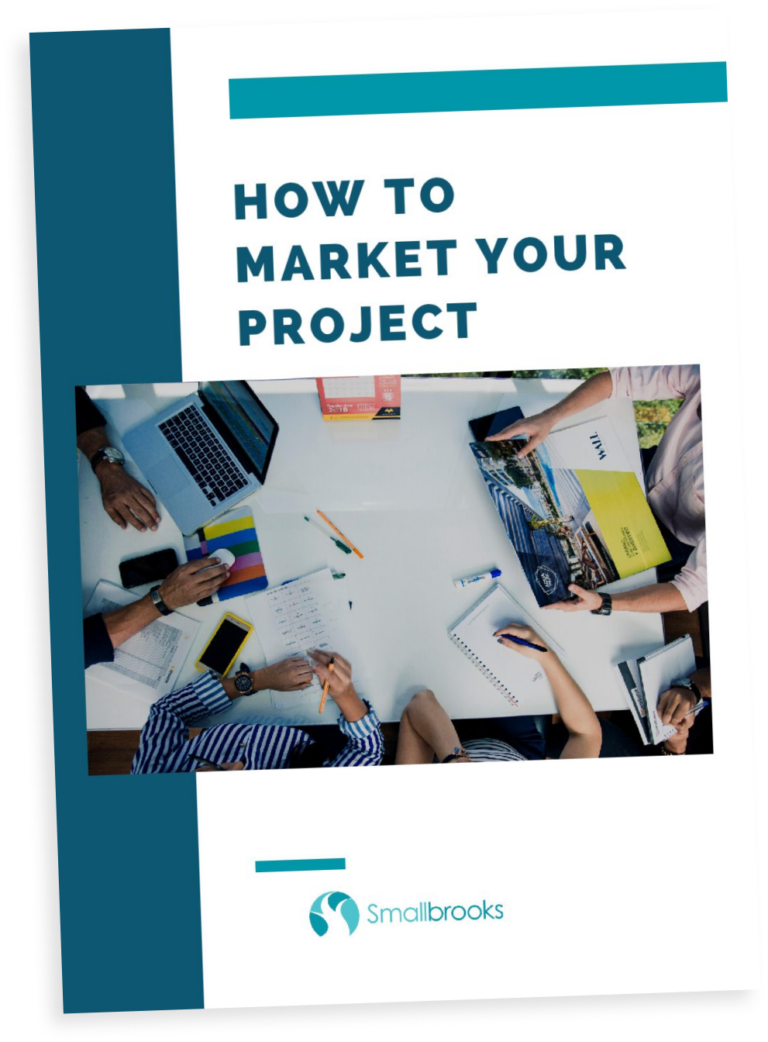Smallbrooks blog
Promoting your crowdfunding campaign
By Mathias Foged
You have the perfect idea for a crowdfunding project, nevertheless, if nobody hears about it, it doesn’t matter. That is why it is important that you have a plan to promote your crowdfunding campaign.
This promotion process demands thorough preparation and hard work before, during, and after the campaign goes live.
With well-prepared and coordinated efforts, your campaign will be both easier and more effective. This is a step-by-step guide on how to best market your project.
Before launching
The most important elements of your campaign start long before it actually goes live.
The crucial foundation of your campaign begins with the early supporters who can spread the word and build momentum. The more structured you work, and the more publicity and interest you can create before the launch date, the easier it will be to reach your goal.
1. Organize yourself

Like everything else in life, crowdfunding is easier if you have a rough idea of what to do and when to do it. Therefore, before you get started, make sure you have a plan and structure your efforts. An hour of planning can easily end up saving you 10 hours of work.
Start by having a dedicated folder or online workspace such as Google Drive or OneDrive, where you and your project partners can organize yourself. Create a detailed project plan that includes a description of all the tasks that need to be performed along with the status and associated deadlines in a calendar. Be sure to gather your marketing materials (videos, press releases, social media posts, etc.) in one place so you can find them easily when needed.
Furthermore, it is also a good idea to have lists or excel sheets with everything you’ll need, from finances to key persons and media contacts.
Make sure to continuously update all information so that you don’t forget anything and thus miss a good opportunity.
Various methods can be employed to structure your work, and you probably know which works best for you. The most important thing is that you set a solid framework for your work throughout the campaign.
2. Network, Network, Network
Your network is where it all begins. Additionally, they are your first supporters and your best advocates. They know you and – hopefully – want to see you succeed with your project. Therefore, it is essential that you activate and engage them from the start. To begin with, get friends and family to support and promote your campaign. Moreover, think about whether you know someone who could play a role in your campaign. Ask your acquaintances or, alternatively, if they know someone who knows someone.
A good start is to map your network and then describe what role you think they can play in your campaign. Maybe you went to school with a local journalist? Or do you know a friend with 3,000 followers on Instagram? Maybe you know someone who knows someone who knows someone…you get the point. All tricks apply.
Make sure to mobilize your closest network and get them to help you with well-defined tasks, such as contacting a specific person or posting on social media on specific days.
Take action systematically. Once you have mapped your network, make sure to document everyone with their role, contact details and other relevant information.
If you take care in good time to build and educate a relevant network of supporters, advocates and other relevant people, you have a much greater chance of getting a good part of your goal financed right from the start of the campaign. Furthermore, at the same time, you manage to show potential supporters who are not part of your network that there are people who believe in you and your idea. This is what we call ‘social proof’, and it is one of the strongest ways to market your project. Additionally, we are more likely to support an idea if others have already done so.
3. The story
Once upon a time…
Your story is often where your campaign stands or falls. After all, people rarely support a campaign out of the goodness of their hearts. They do it because they want to be part of a good story. So it’s up to you to create that narrative.
“Hey, we need money for a local music studio” doesn’t leave the same impression as “We’re three local friends who, having grown up with music as a big part of our lives, want to give back to the local community and provide opportunities for other young people to experience the same joy.”
Explain who you are, what you want to achieve, and especially why. Show that you are passionate about the project and give people a reason to want to hear more. Moreover, people must be able to put the project in a context and you – and your story – are that context.
But how does one do that?
Start with the foundation for every good story: The problem.
All heroes need a “monster” to defeat. For instance, it could be loneliness among young people, the absence of green areas in the city, or unemployment
When considering your own project, ask yourself: What would you like to solve through your project? Who is affected? What will you do to solve the problem? What stands in your way? Furthermore, how can people help make a difference?
Show people what it is they’re helping to solve and why it’s important. This way, you give a role – a place in the story – to those who choose to support you.
Also, remember not only to speak to people’s hearts. It is also important to speak to their brains. I other words, the story must be rooted in reality.

Clearly explain how their contribution will be used and how it will concretely help. Are you buying equipment for a local vegetable garden? or perhaps, you’re planning to pay for the premises of a new chess club for vulnerable young people? or will my DKK 50 go to a seed that will be planted in a new park?
If you have a compelling story that also explains exactly how the challenges in it can be solved, you are pretty well on your way to reaching the goal of your campaign.
4. Channels
You are now completely organized, all your friends and your entire family are involved in the fight, and the story is razor-sharp. Now, it’s time to get it all out. However, where do you start, and which channels are best?
It all depends on who you are, what your project is about and what resources you have. For instance, do you have a big budget? Are you active in local associations? Or, alternatively, do you already have an army of Instagram followers?
The crucial aspect here is to play to your strengths and prioritize correctly. Feel free to choose 3-4 primary channels to focus on. Instead of attempting to be present everywhere, it’s all about being precisely where it works best.
Moreover, make sure you have a plan for which channels you want to use before you launch your campaign.
To get an overview, we review the most common channels here:
Project page
Your project page is the most important tool in your campaign. Consequently, this is where you want to guide people, grab their attention and make sure they choose to support you. Therefore, make sure it works seamlessly.
Your description and pitch should be neat: images and video should be in place, and any rewards should be attractive. It’s not worth getting 1,000 people to hear about your project if they all choose not to click through because your project page is a mess.
Lunch event
Set a date and invite friends and family to a kick-off event!
As previously stated, your network consists of those who start it all. Therefore, if you can’t engage them, it will be difficult to engage strangers.
So buy a few streamers and invite people inside in the warmth for a cozy afternoon or evening, where you can all celebrate the launch of your brand-new idea.
Be sure to send out invitations early in order to get people on board, and feel free to present a timeline of your campaign and maybe a little guide on how to support or help.
Social media
It probably does not come as a surprise that social media plays a big role in the promotion of your campaign. Furthermore, it is primarily here that you can continuously tell your story, share updates and build a community around your project. Tik-tok, Instagram, Facebook and LinkedIn are the most common platforms. You don’t have to choose them all – just the ones that fit your project.
Additionally, a good idea might be to have some posts ready in advance and then schedule them. You can use tools like Hootsuite or Buffer. In case you aren’t a master of graphic design, you can also make your posts using a free tool like Canva.
Be sure to be consistent in your updates. Feel free to be personal and update often, preferably once a day, if possible.
Press
Journalists are always looking for a good story. Therefore, if you’ve done your homework, that’s exactly the kind of story you’ve got. To begin with, make a list of media that you think would be a scoop – and realistic – to be mentioned in.
Next, identify the journalists who may have written about something similar before. Then, send them a press release, or alternatively, pick up the phone and share the details of your project with them. If you’re new to writing press releases, you can find a helpful guide for it right here:
Offline
Nothing beats the internet when it comes to the number of people you can reach with your campaign. However, don’t underestimate how effective it can be to meet your supporters face to face.
Do you have a local project? Stand in front of the local supermarket, and spread the word with home-printed flyers. Alternatively, go door to door with the local business community with your pitch, or even hang up a notice in the local handball club.
You can go a long way with good old-fashioned offline marketing.
People are more willing to support you if they have looked you in the eyes and shaken your hand.
Paid advertising
You can easily reach the goal of your project without having to pay for advertising. Nonetheless, if it’s a big project, and you happen to have a solid budget for marketing, it might be an idea to try out paid advertising.
The easiest thing for beginners is to try social media ads. This way, you can target your ads to those you think will find it interesting, and it doesn’t have to cost a fortune.
It takes a little patience to familiarize yourself with advertising tools like Facebook or google ads, but it can pay off in the end.

Influencers
There is sometimes a certain skepticism about the so-called “influencers” – and often with good reason- but the term covers more than just Instagram camera hogs.
These are often people who have great interest or knowledge in a certain area and who, through hard work and quality content, have built up a crowd that you – if you play your cards right – can take advantage of.
It’s hard to ignore the importance that being mentioned by the right person at the right time can have in your campaign.
For instance, if you spot someone with a big social media presence or a podcast host with a lot of listeners who is a perfect fit for your project, then it might be a good idea to try reaching out to them.
Partnerships
Before you start your campaign, it can be a really good idea to have one or more partners in place. These potential collaborators could include local organizations or businesses that have a vested interest in supporting your initiative, either through financial contributions or by boosting your campaign’s visibility, in return for having their name associated with your campaign.
For example, if you are crowdfunding a local vegetable garden, you might explore the possibility of partnering with a nearby supermarket. Likewise, if your goal is to build a new basketball court, consider enlisting with the local basketball team to participate in a supporting game.
Engaging with partners who are already established can prove to be an invaluable asset.
Launching
The big day has come, you go live! The hardest work is already over.
However, even though the success of your campaign depends primarily on your initial efforts, it is important to maintain the momentum that you have created.
From the moment of launch, there are two things you need to focus on:
1. You reach 30% of your goal during the first week.
2. Keep people engaged throughout the course of the campaign.
If you have read the previous chapter, point 1 should be a no-brainer. Your family, friends and closest network are the ones who must give your campaign a good start by making sure you reach a good portion of your goal. This early progress creates credibility around your project.
However, you also have to do something yourself. Assuming you’ve done your homework, you now have a list of relevant channels and content prepared for them. Now is the time to put it into action.
Hold your launch event, activate your network, send a press release, hand out your flyers, update your social media– and then update it again. Keep sharing your story and showcasing your progress.
Be consistent and active in your work to educate and update your supporters. If people suddenly don’t hear from you, they will quickly forget about you and your campaign will lose momentum.
Therefore, it can be a good idea to distribute your marketing on a timeline, ensuring that there are no dead periods.
In essence, it is about building a snowball effect.
If you’ve built enough excitement around your project before the campaign and can then trigger that excitement through ongoing updates and presence, consequently, then you have a really good chance of getting people on board who hadn’t heard of you before.
Remember not to reduce your efforts if you suddenly find yourself at a standstill in your campaign. Studies show that the majority of your backers will often contribute the most at the beginning and end of your campaign. So if the needle suddenly stops moving,
The key is to just keep going!
After the campaign
You did it! Hopefully. You have now reached the end of the road, and no matter what the result was, there are certain steps that are always good to go through.
To begin with, start by forming an overview of what went well and what went less well. Regardless of whether you reach the goal or not, give yourself a pat on the back for having the courage to launch a crowdfunding campaign.
Crowdfunding is an excellent way to test an idea. In the event that it wasn’t a success, you are now enriched with the experience and can rethink our idea for the next time.
On the other hand, if you reached the goal, there is now some work you have to do.
If you have a reward project, the rewards must of course be delivered. But regardless of the type of crowdfunding you have embarked on, it is a very good idea to show your supporters the result of their support.

You now got the funds you need and have likely built a crowd that wants to see how it all ends.
So, make sure to deliver a satisfying ending to the story. Let people follow the development and make regular updates with the results of the project.
Don’t be one of those people who forgets their supporters as soon as the money is in their pockets. Not only is it lame, but it can also create a jarring reverberation of bad publicity.
Furthermore, often a project needs marketing for more than just funding. You still need positive publicity and attention long after the actual funding goal is reached. So take advantage of the momentum your campaign has built up.
This is precisely one of the many advantages of crowdfunding.
Introduction to crowdfunding
New to crowdfunding? Explore our in-depth guide about crowdfunding and crowdfunding platforms. Everything you need to know in one place.
Need an example?
Want to see examples of the platforms we have built? Dive into our customer stories to discover how crowdfunding platforms have benefited other companies.


